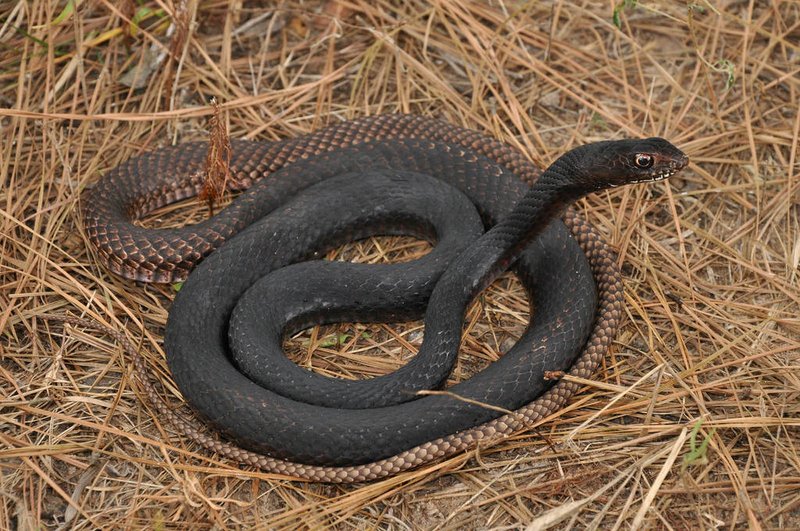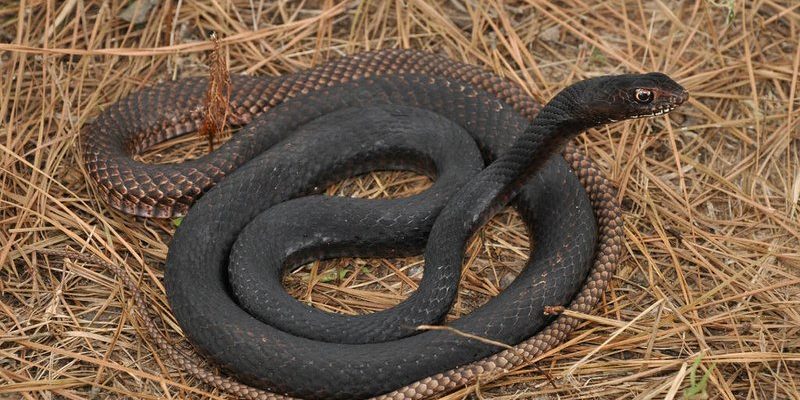
The Coachwhip Snake is a fascinating creature, often catching the eyes of both snake enthusiasts and casual observers alike. With its striking appearance and unique behavior, it stands out in the diverse world of snakes. Imagine a sleek, agile snake darting across the sandy landscapes and scrublands of the southern United States. You might think of it as one of nature’s athletes, always on the move and ready to make a quick getaway when needed.
These snakes are named for their long, whip-like bodies, which can grow impressively long—some reaching over six feet! The Coachwhip Snake’s vibrant coloration ranges from tan to dark brown or black, often with distinct patterns that enable it to blend in with its surroundings. This adaptation not only provides excellent camouflage but also helps it surprise unsuspecting prey. Understanding more about the Coachwhip Snake will reveal just how remarkable these reptiles are.
Physical Characteristics
One of the most striking features of the Coachwhip Snake is its long, slender body. The average length is typically between four to six feet, but some individuals can exceed this. They have a distinctive whip-like appearance that becomes more pronounced as they grow. Their scales are smooth and glossy, which reflect light, making them appear even more striking in their natural habitats.
The coloration of a Coachwhip Snake can vary significantly depending on its geographical location. Generally, their colors range from light beige to dark brown, often with patterns that resemble stripes or bands. These patterns not only enhance their beauty but also serve a purpose—providing them with camouflage in the environment, protecting them from predators. It’s fascinating how their appearance can change so dramatically based on their habitat.
Another interesting aspect of their physical characteristics is their large eyes. These help them have excellent vision, particularly in low light. Their sharp eyesight is crucial for spotting prey, making them effective hunters. When you see one in the wild, you may be struck not only by its beauty but also by the elegance in the way it moves—quickly and gracefully.
Habitat and Distribution
The Coachwhip Snake primarily inhabits the southeastern regions of the United States, extending from Texas to Florida and up to the Atlantic coast. They prefer open areas such as sandy plains, scrublands, and grasslands where they can effectively hunt for food and find shelter. They’re also known to frequent areas with plenty of sunlight, as they are a diurnal species, meaning they’re active during the day.
In these environments, the Coachwhip Snake utilizes its color patterns to blend in with the surroundings, which is vital for both hunting and avoiding predators. Its preferred habitats often include places where they can burrow into the ground or find crevices in rocks, offering them a place to hide when threatened. You might spot them basking in the sun or quickly slithering away when approached.
The adaptability of the Coachwhip Snake is impressive. While they thrive in dry regions, they can also be found in more humid environments, demonstrating their versatility. This adaptability not only helps them survive but also contributes to their distribution across various landscapes, making them one of the more common snakes in their range.
Diet and Hunting Behavior
As carnivores, Coachwhip Snakes have a diet primarily consisting of small mammals, lizards, and even other snakes. Their hunting methods are quite intriguing—these snakes are known for their speed and agility. They can strike quickly, using their sharp teeth to catch and immobilize their prey. You can think of them as nature’s quick-footed hunters, always ready to chase down a meal.
Their hunting technique often involves a lot of movement and endurance. Once they spot their target, they will go into a full sprint, capturing whatever they assess as a meal. Their keen eyesight allows them to track their prey effectively, and their speed is a significant advantage. This is why they are often seen darting across open spaces, which, while beautiful, can make spotting them a bit of a challenge.
Interestingly, Coachwhip Snakes are also known for their ability to consume prey that is relatively large compared to their head size. They achieve this through a process called unhinging, where their jaws can stretch to accommodate larger meals. This adaptability in their diet is part of what makes the Coachwhip Snake such a successful predator in various habitats.
Reproduction and Lifespan
Reproduction in Coachwhip Snakes usually takes place in the warmer months, often from early spring to late summer. After mating, female Coachwhips typically lay clutches of 3 to 24 eggs in sandy or loose soil. The incubation period lasts around 60 to 70 days, which is relatively typical for many snake species. Once the young hatch, they are already independent and able to hunt for themselves right away!
The lifespan of a Coachwhip Snake in the wild is typically around 10 to 15 years, though some individuals have been known to live longer, especially in captivity where threats are minimized. In the wild, their lifespans can be influenced by factors like predation, habitat destruction, and availability of food. Knowing this can help us appreciate the challenges these snakes face in their natural environments.
Interestingly, the Coachwhip Snake exhibits a high degree of sexual dimorphism. Males tend to be smaller and more slender than females, who are typically larger and broader. This difference can be crucial during mating displays, as larger females often attract more potential mates. It’s a captivating aspect of their reproductive behavior, showcasing how different roles can evolve in nature.
Behavior and Temperament
The Coachwhip Snake is often viewed as a flighty species. When threatened, their first instinct is to flee rather than fight. This behavior is beneficial for their survival, as it minimizes confrontation with predators. They can move at impressive speeds, making them hard to catch. If they do feel cornered, they may become defensive, but this is rare. Most of the time, you’ll find them darting away, blending into their surroundings.
While they are generally non-aggressive, some people might worry about encounters with them. Here’s the thing: Coachwhip Snakes are not usually dangerous to humans. Their bites, while painful, are rarely serious and usually only occur if they are handled or threatened. In many ways, they prefer to avoid human interaction just as much as we do. They are more interested in being left alone in their natural habitat.
The social behavior of the Coachwhip Snake is minimal. They are solitary creatures, only coming together during mating season. You might notice them basking alone in the sun or hunting on their own. Their independence is a hallmark of their nature, allowing them to thrive in their environments without the need for social structure.
Conservation Status
The conservation status of the Coachwhip Snake varies across different regions. In general, they are classified as a species of “Least Concern,” meaning they are currently not at immediate risk for extinction. However, habitat loss due to urbanization and agricultural development poses a significant threat to their populations. Keeping track of their status is important, as changes in habitat can lead to declines in numbers.
Local conservation efforts are crucial to ensure that areas where Coachwhip Snakes thrive remain protected. Education about their role in the ecosystem helps dispel myths and promote coexistence. They are beneficial in controlling rodent populations, which is an essential function in maintaining ecological balance.
Awareness of the importance of preserving their habitats is vital for the long-term survival of the Coachwhip Snake. By protecting open areas and preventing overdevelopment, we can help ensure that these beautiful snakes remain a part of our ecosystems. Efforts to create wildlife corridors and maintain native vegetation can make a big difference.
The Coachwhip Snake is more than just a striking reptile; it’s a key player in its ecosystem, demonstrating nature’s intricacies. From their impressive speed and hunting skills to their fascinating reproductive habits, there’s so much to admire about these snakes. Whether you encounter one in the wild or learn about them through research, understanding the Coachwhip Snake enriches our appreciation for wildlife.
As we continue to explore the stories behind these amazing creatures, let’s remember to respect their spaces and recognize their roles in our natural world. After all, every species has its place, and the Coachwhip Snake is no exception. So, the next time you’re in the southern U.S., keep an eye out for this incredible snake—you might just catch a glimpse of its beauty in action.
FAQ
Are Coachwhip Snakes venomous?
No, Coachwhip Snakes are non-venomous. While they have sharp teeth and can bite if threatened, their bites are generally not serious and are more of a defensive mechanism than an attack.
How can you tell a Coachwhip Snake apart from other snakes?
Coachwhip Snakes are easily recognized by their long, slender bodies and distinctive coloration, which often features bands or stripes. Their large, prominent eyes also set them apart from many other snakes.
What is the best way to observe a Coachwhip Snake in the wild?
To observe a Coachwhip Snake, it’s best to visit their natural habitats during sunny days when they are most active. Look for them in sandy or open areas where they are likely to bask or hunt. Always keep a respectful distance to ensure both your safety and theirs.
Do Coachwhip Snakes make good pets?
While Coachwhip Snakes can be kept as pets, they require specific care and conditions to thrive. They need ample space to move around and should be handled minimally to reduce stress. If you’re considering one as a pet, be sure to research their needs thoroughly.
What are the main threats to Coachwhip Snakes?
The primary threats to Coachwhip Snakes include habitat destruction due to urban development, agriculture, and road mortality. Additionally, climate change can alter their habitats, making it essential to protect these beautiful creatures.
How fast can a Coachwhip Snake move?
Coachwhip Snakes are among the fastest snakes in North America. They can sprint at speeds of up to 3 miles per hour, which is quite impressive for their size and allows them to evade predators easily.
What do young Coachwhip Snakes eat?
Young Coachwhip Snakes primarily eat small invertebrates and lizards. As they grow, they transition to larger prey, including small mammals and other reptiles. This adaptability in diet helps them thrive in different environments.
How do Coachwhip Snakes find their prey?
Coachwhip Snakes use their excellent vision and sense of smell to locate prey. They actively hunt during the day, using their speed and agility to catch faster animals. Their ability to blend into their surroundings also aids in stalking prey.
Can Coachwhip Snakes swim?
Yes, Coachwhip Snakes can swim! While they are primarily terrestrial, they are capable of moving through water and will sometimes do so to escape predators or reach new habitats.
How do Coachwhip Snakes adapt to their environments?
Coachwhip Snakes have adapted to their environments through various means, including their coloration for camouflage, dietary flexibility, and ability to thrive in a range of habitats, from dry sandy areas to more humid settings.
Are there different species of Coachwhip Snakes?
Yes, there are different subspecies of Coachwhip Snakes, which can vary in color and pattern across their range. Each subspecies has adapted to its specific habitat, ensuring they can survive in diverse environments.

